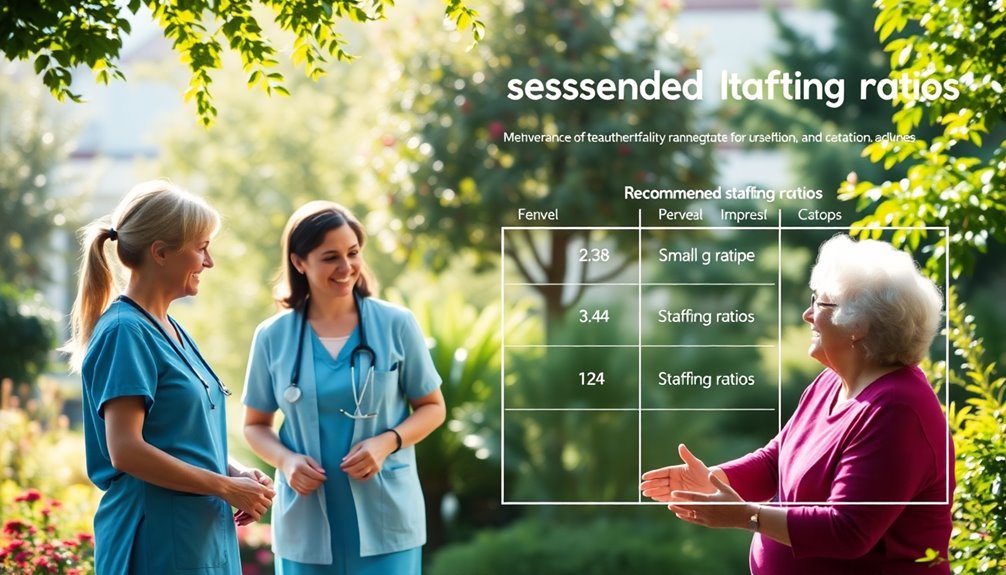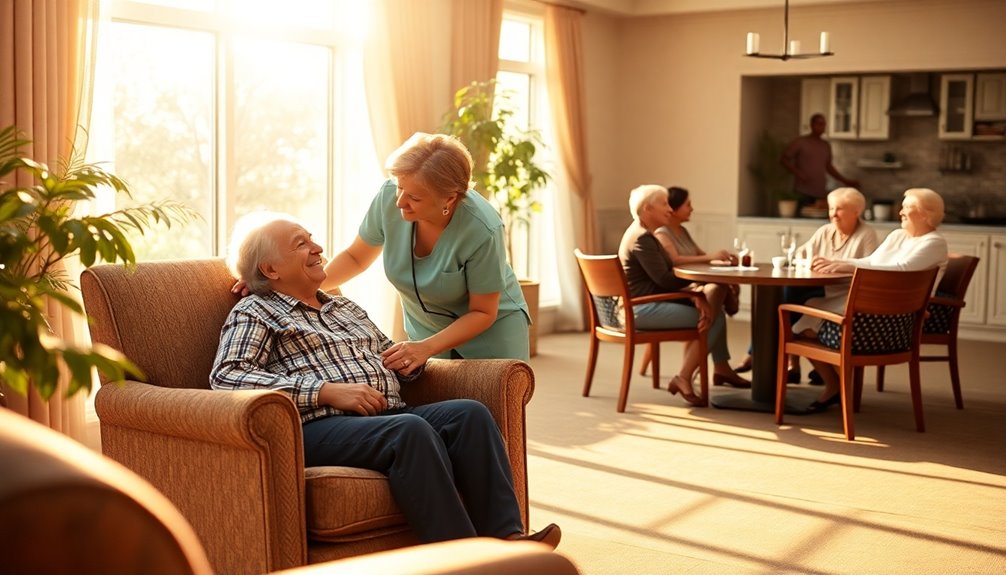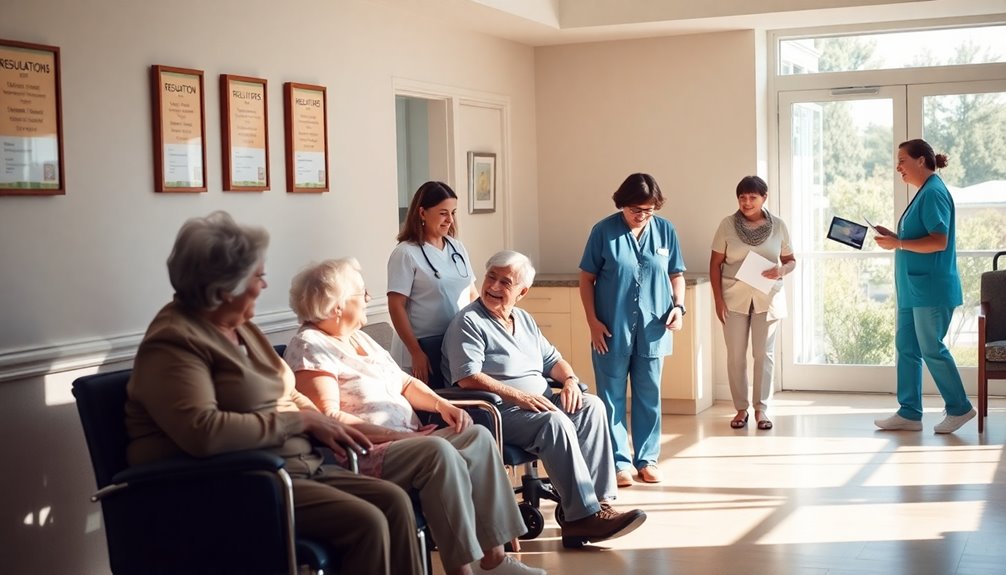In assisted living, caregiver-to-resident ratios typically range from 1:6 to 1:20, depending on resident needs and facility size. During the day, the ratio is usually around 1:5 to 1:8, while at night, it may increase to 1:10 to 1:15. Lower ratios mean quicker response times and more personalized care. Understanding these ratios is key to ensuring your loved one's well-being. Discover more about the factors influencing staffing in assisted living facilities.
Key Takeaways
- Staff-to-resident ratios in assisted living typically range from 1:6 to 1:20, depending on resident needs and facility size.
- Daytime caregiver-to-resident ratios are generally between 1:5 to 1:8, while nighttime ratios can rise to 1:10 to 1:15.
- Twelve states enforce specific caregiver-to-resident ratios, while 38 states have no regulations.
- Lower caregiver-to-resident ratios allow for quicker response times and more personalized care for residents.
- Higher staffing levels are linked to fewer incidents, such as falls and emergencies, enhancing resident well-being.
Understanding Staff-to-Resident Ratios in Assisted Living

Understanding staff-to-resident ratios in assisted living is essential for ensuring quality care. The average staff-to-resident ratio in assisted living facilities ranges from 1:6 to 1:20, heavily influenced by the residents' needs and facility size.
During the day, caregiver-to-resident ratios typically range from 1:5 to 1:8, allowing for more attentive care. However, at night, this can increase to 1:10 to 1:15 due to lower activity levels.
It's vital to evaluate factors like the severity of conditions and state regulations when assessing these ratios. A lower staff-to-resident ratio may suggest less frequent assistance, while a higher ratio often means more personalized, responsive care from caregivers.
Always check for CPR-certified staff and nursing availability as well.
Importance of Caregiver Ratios for Resident Well-being

When considering the well-being of residents in assisted living, caregiver ratios play a significant role in ensuring that individuals receive the attention they need. A favorable caregiver-to-resident ratio, typically between 1:6 and 1:20, directly impacts the quality of personalized care you can expect.
With lower ratios, caregivers can respond more quickly to your needs, enhancing your overall quality of life. Facilities with higher staffing levels report fewer falls and emergencies, creating a safer environment for everyone.
This is especially important for residents with complex health conditions, as more individualized attention leads to timely interventions. Ultimately, consistent staffing ratios promote better resident well-being by ensuring you get the care and support necessary for your daily activities.
Factors Affecting Staffing Needs in Assisted Living Facilities

Caregiver ratios are influenced by several factors that directly impact staffing needs in assisted living facilities.
Here are three key considerations:
- Level of Care: Residents requiring more assistance demand a higher staff-to-resident ratio to guarantee proper support.
- Facility Size: Larger facilities typically need more qualified staff to meet the diverse demands of their resident population effectively.
- State Regulations: Variability in minimum staffing requirements across states can greatly affect the quality of care provided.
Additionally, external factors like staff turnover, illness, and weather conditions can impact caregiver availability.
Understanding these elements helps facilities maintain an adequate staff-to-resident ratio, ensuring residents receive the necessary care and attention for their well-being.
Recommended Staffing Ratios for Different Care Levels

As the needs of residents vary, recommended staffing ratios in assisted living facilities are tailored to different care levels. Generally, the staff-to-resident ratio ranges from 1:6 to 1:20, depending on the care required.
For those needing more personalized care, especially in memory care settings, daytime ratios often stand at 1:5 or 1:6. At night, when resident activity decreases, staffing can shift to ratios of 1:8 or 1:10.
State regulations play a significant role, with only twelve states enforcing specific caregiver-to-resident ratios, while 38 states leave it unregulated.
In facilities catering to residents with advanced dementia or higher assistance needs, lower ratios are essential for ensuring adequate support and personalized care.
Key Questions to Ask About Staffing Ratios

How can you confirm your loved one receives the right level of care in an assisted living facility? Start by asking these key questions:
- What's the staff-to-resident ratio during the day and night?
- How does the ratio change based on resident needs and activity levels?
- What measures are in place to guarantee quality of care with the current caregivers to residents?
Understanding the staffing ratios is essential.
The industry average can range from 1:6 to 1:20, markedly influencing the quality of care. Lower ratios often mean quicker response times for residents needing assistance.
The Role of Caregiver Qualifications and Training

Understanding caregiver qualifications and training is essential when considering assisted living options.
You'll find that standards can vary greatly, with some caregivers holding certifications while others receive on-the-job training.
Specialized care certifications and ongoing education requirements also play an important role in ensuring residents receive the best possible support.
Caregiver Training Standards
While caregiver training standards vary markedly across states, the qualifications and training of caregivers play a crucial role in the quality of care residents receive in assisted living facilities.
Consider these key factors:
- Many caregivers undergo on-the-job training, but certifications like nursing assistant can enhance staff qualifications.
- Most states require background checks and CPR certification to guarantee safety and competence.
- Facilities that prioritize ongoing training for trained staff can better meet residents' complex needs.
The quality and extent of caregiver training directly influence the level of care provided, impacting residents' overall well-being. Moreover, understanding filial responsibility laws can help families navigate financial obligations related to elder care.
Specialized Care Certifications
Specialized care certifications substantially enhance the qualifications of caregivers in assisted living environments. While many caregivers receive on-the-job training, certified nursing assistants (CNAs) often have specialized training in areas like memory care and first aid. This expertise allows them to meet diverse resident needs effectively.
| Certification Type | Description |
|---|---|
| Memory Care | Specialized training in dementia and Alzheimer's care |
| CPR | Certification in cardiopulmonary resuscitation |
| First Aid | Training to handle medical emergencies |
| Ongoing Education | Continuous skill development to improve care quality |
Facilities often prioritize hiring caregivers with these certifications, ensuring tailored support for residents. Ongoing education is essential for adapting to the evolving needs of those in their care.
Ongoing Education Requirements
Ongoing education is essential for caregivers in assisted living, as it helps them adapt to the ever-changing needs of residents.
Here are three key aspects of ongoing education:
- State Regulations: Many states set minimum training hours for caregivers, ensuring they meet necessary standards.
- Emergency Preparedness: CPR certification is often required for at least one staff member on duty, highlighting the importance of being prepared for emergencies.
- Specialized Training: Caregivers receive ongoing education on best practices and specific conditions like dementia or diabetes, improving care quality. Additionally, understanding financial stability post-divorce can aid caregivers in providing support to residents facing familial challenges.
State Regulations Impacting Staffing Levels

State regulations play a vital role in determining staffing levels in assisted living facilities.
You'll find that specific requirements vary widely from state to state, impacting how many caregivers are available to meet resident needs.
Understanding these regulations is essential for ensuring compliance and delivering quality care.
Varying State Requirements
While many caregivers endeavor to provide quality care, the staffing levels in assisted living facilities can vary widely due to differing state regulations.
Here are three key factors to take into account:
- Minimum Staffing Levels: Twelve states enforce specific caregiver-to-resident ratios, while thirty-eight do not.
- Care Needs: State regulations often dictate caregiver numbers based on residents' individual care needs, affecting staffing ratios.
- Staff Qualifications: Some states require CPR-certified staff and ongoing training, further influencing the caregiver availability.
These variations can lead to significant differences, with ratios ranging from 1:6 during peak hours in regulated states to as high as 1:20 in less regulated areas.
Understanding these differences is essential for families considering assisted living options.
Licensing and Compliance Standards
Understanding the licensing and compliance standards for assisted living facilities is vital, especially since these regulations directly impact staffing levels.
In twelve states, specific staffing ratios are mandated to guarantee adequate care for residents. Meanwhile, 38 states lack such requirements, which can lead to variability in caregiver availability.
Licensing involves passing inspections that evaluate compliance with these standards, including the qualifications of caregivers. Facilities may also need to have at least one CPR-certified staff member on duty to enhance resident safety.
It's important to adhere to these staffing regulations, as failing to meet state standards can result in penalties, such as fines or loss of licensure, jeopardizing the facility's ability to operate effectively.
Resident Needs Considerations
Regulations around staffing levels in assisted living facilities can greatly influence how well resident needs are met. Understanding these regulations is essential for ensuring quality care.
Here are three key factors:
- Minimum Staffing Ratios: Twelve states enforce specific staff-to-resident ratio requirements, while 38 do not.
- Individualized Care Requirements: Some states allow staffing to be based on assessed resident needs, offering flexibility in ratios.
- Specialized Training: State laws often require caregivers to have specialized training, impacting staffing levels and care quality.
These factors can lead to an average staff-to-resident ratio ranging from 1:6 to 1:20.
Consequently, it's important to take into account state regulations when evaluating how effectively assisted living facilities can meet residents' diverse needs.
Challenges in Maintaining Ideal Staffing Ratios

Maintaining ideal staffing ratios in assisted living facilities presents significant challenges that can impact the quality of care. High turnover rates in direct care roles often hinder your ability to keep consistent staffing, which increases stress for remaining caregivers. Financial constraints can limit hiring, affecting overall staff-to-resident ratios and potentially compromising care quality. Additionally, varying resident needs, especially for those requiring more assistance, demand more caregivers. Seasonal factors like flu outbreaks can further exacerbate staffing shortages, making it even tougher to maintain desired ratios.
| Challenge | Impact on Care Quality |
|---|---|
| High Turnover | Inconsistent care |
| Financial Constraints | Limited caregiver availability |
| Resident Variability | Increased staffing requirements |
Strategies for Improving Staff-to-Resident Ratios

To improve staff-to-resident ratios in assisted living facilities, you can implement several effective strategies that directly address common challenges:
- Leverage Technology: Utilize electronic health records and scheduling software to enhance staff management and streamline operations.
- Invest in Training: Provide ongoing training and development for your caregivers to reduce turnover rates, ensuring experienced staff are consistently available.
- Adopt Flexible Staffing Models: Create adaptable staffing plans that respond to peak resident activity times, optimizing caregiver availability.
Frequently Asked Questions
What Is the Ratio of Caregivers to Residents?
When you're looking at the ratio of caregivers to residents, it typically ranges from 1:6 to 1:20, depending on care needs and local regulations.
During the day, a 1:5 or 1:6 ratio is ideal for memory care, while nighttime ratios can reach 1:8 or 1:10.
Higher ratios generally lead to better response times and more personalized support, greatly enhancing the overall satisfaction and safety of residents in assisted living settings.
What Is the Nurse to Patient Ratio in Assisted Living?
In assisted living, the nurse-to-patient ratio typically ranges from 1:8 during the day to 1:15 at night.
This means you'll often find more nurses available when residents need the most help.
Since state regulations don't require strict ratios, some facilities rely on caregivers for daily support, while nurses handle tasks like medication management.
If a resident has higher medical needs, the facility might adjust these ratios to guarantee everyone gets the care they require.
How Often Should You Visit Your Parents in Assisted Living?
You should aim to visit your parents in assisted living at least once a week.
Regular visits help maintain emotional connections and allow you to monitor their well-being.
However, consider their individual needs and preferences—some may appreciate more frequent visits, while others might prefer a bit more space.
Stay flexible and communicate with them to find a visiting routine that feels right for both you and your parents.
What Is the Ratio of Staff to Residents in a Care Home?
Have you ever wondered how much attention your loved one receives in a care home?
The staff-to-resident ratio can vary considerably, typically ranging from 1:6 to 1:20. During the day, you'll find a common caregiver ratio around 1:8, while night shifts might increase to 1:15.
Facilities adjust these numbers based on residents' needs, ensuring that those requiring more assistance get the personalized care they deserve. This balance is essential for their well-being.
Conclusion
So, when you think about caregiver ratios in assisted living, remember: you wouldn't want a chef cooking for a hundred people, right? Likewise, your loved ones deserve more than a lone caregiver juggling a dozen residents. After all, if you're going to trust someone with your daily snacks and stories, shouldn't they have a bit of backup? Let's aim for a world where caregivers don't need superhero capes—just reasonable ratios!









